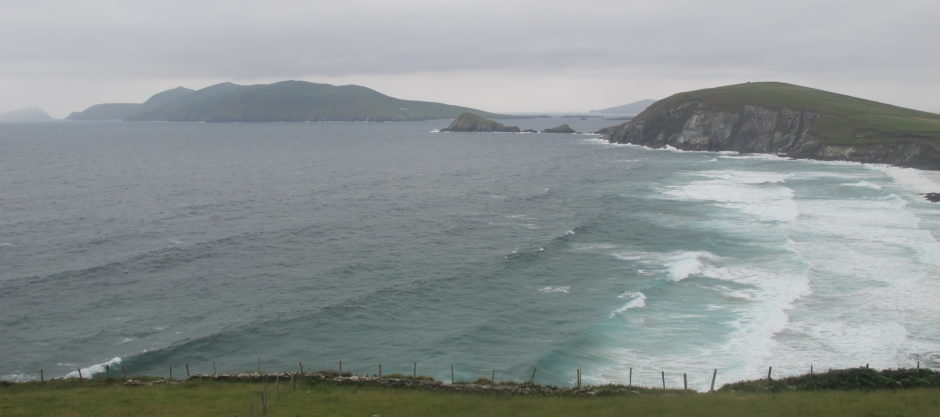Weeks in the World – Spain – Explained
I post my blogs after my travel, but still in reverse order, so this post is to summarize what you will read below. If you want to read from the beginning, scroll to the bottom.
This blog records and celebrates my first trip to Spain. I went on a bus tour with my mother Sandra, flying into Barcelona and out of Madrid.
Adios!
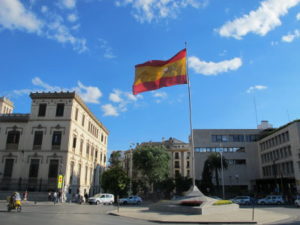
This is the final post in a blog about Spain, where I spent June 7-22, 2018 on vacation on a bus tour with my mother. Our tour started in Barcelona and ended in Madrid. The header photo here is a view in Toledo.
To read the blog from the beginning, scroll down. To read other blogs about other trips, see other parts of this website.
I thought I’d leave this last post for a few final thoughts.
Taking a tour of Spain and getting to see different areas was a nice way to see both the unity of the country and the differences between regions. I liked that our tour took us to different sized cities in addition to the major cities of Barcelona, Madrid and Lisbon. It was interesting to see some of the smaller centres as miniature versions of the big cities, especially ones with special features like the walls of Toledo.
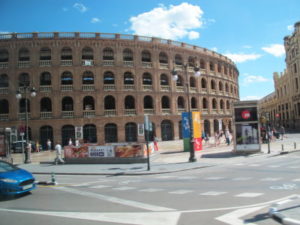
It was also interesting to visit a city in Portugal and to learn about some of the similarities and differences between the two countries.
Besides the history of various regions, our tour guide Jorge also gave us some details about different civic systems in Spain, like the education system and the social support from employment to retirement. Both sound quite similar to Canada, with a decent amount of state support.
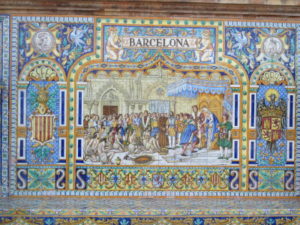
People keep asking me, and we kept asking each other on the tour, what was our favourite city? I found that question really hard to answer, as there were different aspects that stood out in different places. I think that if there’s a unity, it’s the common attitude that struck me. Not the stereotype of the siesta culture, but a general friendliness.
The landscapes were also really attractive, both the natural with mountains and palms and the city landscapes with old-world squares and patios. I was really fascinated by the history of Christian and Moorish dominance over the years, and the evidence of that blend in the various buildings decorated in both Islamic and Christian styles.
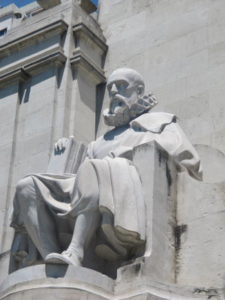
Despite being on vacation, it was not lost on me that the country faces modern political and social issues. We saw different protests in downtown squares, and one day we couldn’t return to our hotel at midday because it was in an area cordoned off for a protest.
Also, just six days before we arrived, the prime minister had been ousted and replaced in the congress https://en.wikipedia.org/wiki/Next_Spanish_general_election
And while we were visiting, Spain had opened its port to migrants that Italy that other countries had refused https://www.cnn.com/2018/06/17/europe/migrant-ships-dock-spain/index.html It was interesting to think of the migrants arriving in Valencia where we had left just a few days earlier.
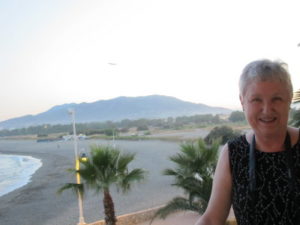
But returning to life as a tourist, I think this is a fun country to visit because of the landscapes, the food and the culture. I finally satisfied my curiosity about one of the few western European countries I’d never set foot on.
The weather is also great because it is my kind of temperature. I love 30 degrees Celsius with a breeze. Although, as I’ve mentioned, I was reminded that I am not as much a fan of temperatures over 35 degrees. Luckily, as our tour guide noted, we happened to visit in a week that was relatively cool for this time of year, so days were mostly below rather than above my golden temperature. Thank goodness we booked for June!
Special issues (okay, it’s all about food and flamenco)
June 22, 2018
Here’s my regular post at the end of a trip where I talk about special issues that don’t fit into the day-by-day accounts even though they thread through the trip. This time it’s all about food, flamenco and fifty years later.
FOOD
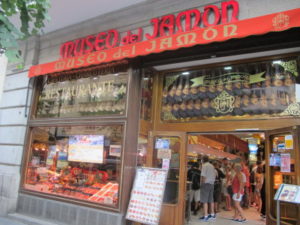
It’s time to talk about tapas. I had already known about this approach to eating, whereby you order a bunch of appetizers and the meal is a series of tastes, but in Canada a tapas meal at a restaurant tends to be fairly expensive, at least the ones I’ve attended.
In Spain, tapas is not only tasty but seems like an affordable approach to food. Both because you order a bit at a time and stop when you are full, but also because the tapas themselves are mostly not too pricey: most of what we tried were between 1.50 to 4.00 euro.
We sampled a variety of dishes, including mushrooms in garlic, chorizo sausage, cheeses, ham croquettes, and my favourite, Spanish omelette, a pie made with potatoes and eggs and a bit of onion. I’m going to learn to make that one at home.
I also had a lot of food that I already knew and liked. I’m looking at you, olives. Apparently, there are many varieties but the standard at many restaurants seem to be green with pits, with some of the darker coloured ones on offer as well. I’m trying to ration the big jar I got at the airport that is now in my fridge, but it is not going well.
Another salty food was the cured ham, Serrano and Iberico (they use the word York to describe what I think of as a more standard lunch meat ham in Canada). Ham was available at many of the hotel breakfasts as well as seemingly as the most common sandwich offering. In Canada, I think prosciutto is our more common cured ham, and for those who haven’t tasted the Spanish variety that’s the taste that it most resembles to me.
The common cheese is called Manchego, which the internet tells me is made in the La Mancha region using milk produced by sheep of the Manchego breed. The internet also confirms that the milder version is aged for less time (two weeks) while the stronger cured version that I prefer is aged longer.
I mentioned a yellow beans snack we found at the beer garden in Lisbon and when I got home I googled it. In Portugal the snack is called “tremocos” and are pickled Lupin beans (they look like fava beans), and are generally eaten by removing the shells (something I didn’t realize until Mom pointed out other people were doing so as they ate them; hey! I’m usually the one who says “watch other people to see how it’s done”). Apparently, the beans are toxic until soaked and pickled! I will be looking in the international section of the grocery stores here to see if they carry them.
We did sample a couple of sweet things that were not to my taste because I don’t like things that are too sugary tasting (for example, I’m a bad Canadian because I don’t like butter tarts). The most common was nougat, of which our tour guide kindly gave us as a sample. Another that Mom was looking all over for was marzipan, which she remembered enjoying on her trip 50 years ago. We didn’t see it as frequently as she recalled in the past, but we did finally find some in Toledo. And ironically at the airport. One sweet that I loved, again a treat from our guide, was Portuguese egg tarts, containing a nice creamy filling with a crunch crust. Also I think that chocolate croissants are just plain better in Europe, with more chocolate.
Red wine was also a nice discovery. I started out drinking white wine as red wine sometimes gives me a headache, but I switched over when I realized that I overwhelmingly prefer the red for its full-bodied taste. Sangria is a regular offering too and refreshing as it is often served with lots of ice and fruit.
FLAMENCO
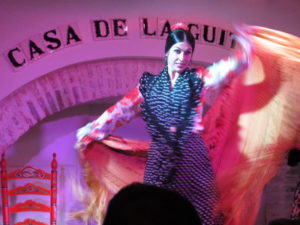
Another special sampling in Spain was Flamenco, which I’d been curious to watch live. We chose a show at the Spanish guitar museum in Seville because it started relatively early at 6:00 pm, giving us lots of time to get back to the hotel.
I’d never seen live flamenco before, and my first surprise was about how percussive it is – not only do you have the clapper who keeps the pace, but the pounding of the flamenco dancer’s shoes, and then the guitar rhythm.
Our show started with the guitar player doing a couple of solo songs and then the singer who was also the clapper joining in on a couple of songs. She had a very powerful voice and an arresting gaze. The dancer, who came out for a first number, and then after a costume change a second couple of dances, shared similar mannerisms, with a bold look at the crowd and very stylized hand movements.
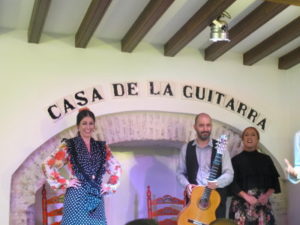
The dance reminded me of elements in a couple of other art forms, first the impressive precision of the hand movements and tiny movements in wrists and torso reminded me of some of the precision of belly dancing and also of hip hop.
Some of the performers’ interactions also reminded me of jazz, as the singer would listen to the guitar and say an “hola” occasionally when you could tell she was feeling his vibe, nodding her head like she was really listening, and he reciprocated.
Our show lasted about an hour, and was a good taste of the art form, although we heard later that the optional flamenco show included with our tour had even more dancers and singers.
50 YEARS LATER
Yet another element that made this trip special was returning with my Mom. It’s been 50 years since she visited Spain. I hope I wasn’t too annoying asking all the time about whether things were different, but I think her conclusion is that are more similarities than differences when your visit focuses on the old parts of town anyway. When things are hundreds of years old, 50 years does not make much of a difference. That was confirmed for me when we looked at Mom and Dad’s slides (if you’re picturing an old-fashioned slideshow with screen, that’s accurate) from Spain, which we did before and after the trip. Mom had also kept a diary of their whole trip, which she let me read.
The major differences were that some buildings had been cleaned (while others had tarnished). Mom was also able to identify a few elements (for instance she had forgotten about St. Michael’s Cave so was able to place a random cave photo in the middle of Gibraltar pics). Plus Mom and Dad looked so young in their 20s and the cars were all sixties models in the photograph, including their cute VW bug.
Celsius with a breeze. Although, as I’ve mentioned, I was reminded that I am not as much a fan of temperatures over 35 degrees. Luckily, as our tour guide noted, we happened to visit in a week that was relatively cool for this time of year, so days were mostly below rather than above my golden temperature. Thank goodness we booked for June!
The Prado at last
June 21, 2018
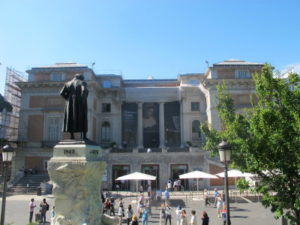
Our last day in Madrid was designated for the Prado, Madrid’s famous art museum https://www.museodelprado.es/en. We covered it pretty thoroughly, spending about six hours there with a break for lunch at a restaurant we had discovered the other day that served sandwiches and drinks for a euro apiece.
You’re not allowed to take photos in the Prado, which was surprising considering that many other museums have loosened their policies (mostly the policy has been photos but no flash). Mom was disappointed.
The Prado contains major artworks by most of the European masters including a big collection of El Greco and Goya and other Spanish painters into the nineteenth century, so it was interesting to learn about the history of Spanish art. There are also a lot of Flemish paintings and other masters.
By the time we left the museum at 4:00 pm and wandered around for some souvenirs, it was time for a quick bite and to go back to the hotel to pack our suitcases.
Holy Toledo
June 20, 2018
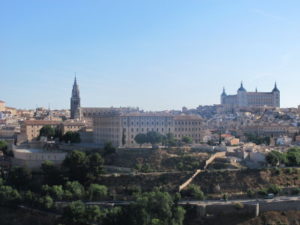
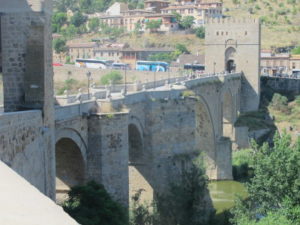
Today we went on an excursion trip to Toledo, about 75 km outside of Madrid. Mom remembers this town particularly well from her time in Spain and liked it for the vistas and the fact that it is a walled city. Our tour guide gave us a bit of the history of the city, which served as the capitol of the region of Castile intermittently and has a long history dating back to the Romans.
On our arrival, we drove first to an outlook where we could take photos. The view really was one of the most spectacular we’ve seen so far, with the cathedral and the mosque in particular standing out among the other roofs.
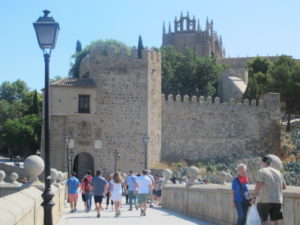
Then we took an escalator up through to an even higher point, actually six escalators up through the mountain. That made Mom laugh, because when she was last
there 50 years ago, there was only a dusty path and certainly no technology like this.
Not that we minded having the escalators available.
In the city, we walked along with our local guide through the streets to get a taste of the city with its narrow streets and cobblestones.
We went into the Church of Santo Tome that houses a masterpiece by El Greco called “The Burial of the Count of Orgaz”.
Our tour guide provided a detailed explanation of the history of the canvas (created in 1584) and pointed out various elements of the art work, see https://en.wikipedia.org/wiki/The_Burial_of_the_Count_of_Orgaz
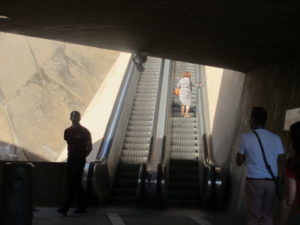
We also went into the Santa María la Blanca, a synagogue that was also for a time a church and constructed by Islamic architects.
Our final stop was to see a handicraft called damascene where metals are inlaid into each other, and we saw both the blacksmith shop where the steel is forged and the crafts people working in their studio to create the jewelry. Souvenirs of the pendant variety were acquired.
Back in Madrid for the afternoon, Mom and I decided to check out the Thyssen-Bornemisza museum https://www.museothyssen.org/en because we had already bought tickets online to the Prado museum for the next day (again I had been a bit worried about selling out).
We first found a really cute place for lunch called “Cervantes”, which seemed like just an ordinary bar. But then we were led through to a charming indoor patio with plants and tiles. After lunch of tostas and drinks, we went into the Thyssen, which was definitely not around last time Mom was here–it was founded only in 1992. Based on the private collection of its name family, the collection was eclectic but contained many works by famous painters including el Greco, Goya, Reubens and Rembrandt.
After the Thyssen we had just a bit of time for a quick dip in the pool (it was above 37 degrees Celsius again) before attending a farewell dinner at the hotel to say goodbye to our tour group.
Arrival in Madrid
June 19, 2018
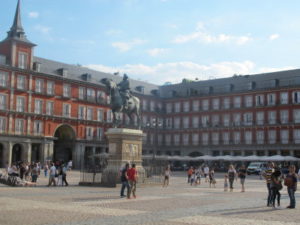
Today we headed for Madrid, a trip made shorter because we’d done so much driving the day before. We arrived in the early afternoon, after making a nice photo stop just outside of the walled city of Avila.
In Madrid, we first went on an orientation tour with a local guide on our bus where we drove past some of the major squares of Madrid including the Plaza Mayor and Puerta del Sol with its statue representing the coat of arms and its bear and strawberry tree. We also stopped at a monument to Miguel Cervantes (author of the novel Don Quixote, which I studied in my undergraduate degree) in the Plaza d’Espana.
There we also saw some pick pockets, which our local guide actually called the police on, who were disguised as people asking tourists to fill out a survey. She recognized their tactic immediately. When the guide called them out, they gave us the finger and shouted some words that our Spanish-speaking tour companions said were not very nice. We’ve heard warnings about sophisticated pickpockets from everyone here in Spain, so we’ve been being very careful and also locking our passports in the hotel safe where possible, mostly carrying only photocopies.
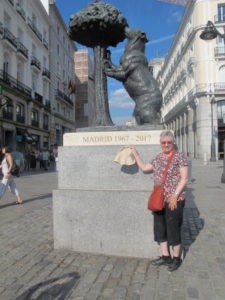
After out tour we returned to our hotel which was somewhat north of the city, and then Mom and I headed downtown to explore some of the squares more carefully.
The weather was once again very hot, so we had a nice pitcher of sangria and some ham and cheese at a restaurant called Museo de Jamon which we thought was unique and later realized was a chain (it was still fun: bustling, with wrapped hams hung from the ceiling to cure).
On the road again – to Salamanca
June 18, 2018
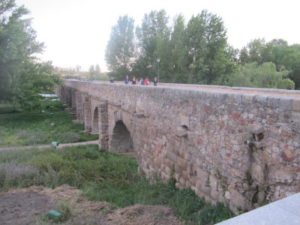
This was our major driving day, from Lisbon, Portugal to Salamanca, Spain.
As our first break, we made a stop at the Catholic pilgrimage site of Fatima https://en.wikipedia.org/wiki/Our_Lady_of_F%C3%A1tima, which was interesting to learn about. Our tour guide showed us a short film about the three children who saw a vision of the angel of Gabriel in their little town of Fatima, a site that has now grown to the point where over eight million visitors and pilgrims make their way there annually. At the site, there’s an old and new cathedral and a huge square for religious gatherings.
Later in the day we crossed the border from Portugal back into Spain.
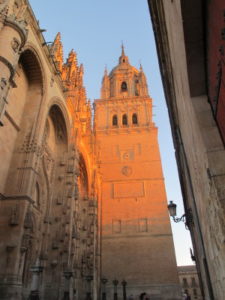
Arriving in Salamanca late afternoon, we found a cute little town with cobblestones, public squares, and another ornate cathedral. Again, it was like a condensed version of some of the bigger cities, which made it cute and manageable to walk around.
We went for a wander downtown from our hotel to check out some sights like the cathedral and main square. On the way is a bridge built in Roman times and only recently handed over to pedestrian traffic only.
We tried what has become our regular fare of red wine and cerveza with tapas, sampling a couple of new ones in tasty ham croquettes and empanadillas.
From museums to football in Lisbon
June 17, 2018
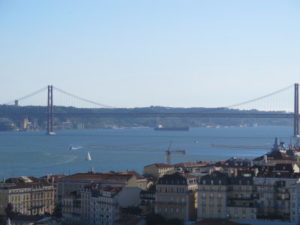
This morning we started out with a tour of Lisbon provided by our tour with a local guide. We saw sights like Edward VII park which has a nice view of the city, Rossio Square and the Commerce Square. We drove out to an area with several museums where we saw the iconic Belem tower (completed in 1521), the Jeronimos monastery, and the more recent Monument of the Discoveries, opened in 1960 to celebrate Portuguese age of discovery in the 15th and 16th centuries.
Mom and Dad have a photograph taken in profile at the monument (less than a decade old at the time of their trip), so we recreated that with Mom standing in the same spot.
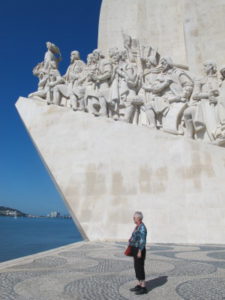
Afterwards, we had some free time from our tour, so we went to the Calouste-Gulbenkian museum https://gulbenkian.pt/museu/en/. It’s an eclectic collection by a philanthropist who amassed artifacts from paintings by masters like Monet and Reubens to nineteenth-century furniture to artifacts from the Ottoman empire.
The museum was bigger than I expected, and in its eclecticism reminded me of the Frick in New York city, similarly the product of a life-long collector. The museum continues to acquire works, and it was also interesting to visit the modern collection and learn about trends in contemporary Portuguese art.
After the museum, we took a break to watch football (soccer to North Americans) in an outdoor beer garden. We were lucky enough to be in a football-crazed nation at the time of the World Cup playoffs, so the space was filled with intensely silent fans watching a big outdoor screen. World Cup started a couple of days earlier with Spain and Portugal playing a tied match and this game between Mexico and Germany still attracted some intense supporters despite not being the national team. I finally found cider on the menu (my drink of choice at home, besides wine) and discovered a new snack in “yellow beans” or “tremocos” that I would later google (see “food” post :))
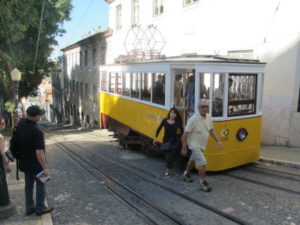
After watching the game for a while, we decided to wander over to Rossio square. But we got distracted when we came across the tram car that goes up the hill and realized that our 24-hour transit passes were good for the tram. So we went up the hill in the chugging, bumpy yellow tram. Then we had to walk down again.
We lucked out to land back in Rossio square, where we took pictures of the national theatre and the column of Pedro IV, king of Portugal (the square is also named for him). We then walked down the street towards the water and the Praca de Commercio or Commerce Square that overlooks the Tagus River. There we took pictures of the statue of King Jose, established in 1775 as part of the rebuilding after the earthquake of 1755 that destroyed much of the city https://en.wikipedia.org/wiki/1755_Lisbon_earthquake
The square also was a backdrop to a modern gathering: crowds for the next football match that was to start at 7:00 pm and feature Brazil and Switzerland. There seemed to be a lot of Brazil fans in Portugal (I’m assuming because of the language crossover?) because the DJ hyping the crowd in front of a huge screen TV said something that must have been like “are we cheering for Switzerland” to dead silence, and then “are we cheering for Brazil” to pandemonium.
While all this was happening, we went to the waterfront and sat on the steps where the water was coming in and just watched the square filled with people. As the game began and we left the square, we noticed a heavy police presence, presumably for crowd control. We found our way back to the square where we had eaten dinner the night before and got a cheese plate and some different grilled sausages along with a nice sangria. I, of course, repeated my cup of olives for one euro purchase. Then we made our way back to the hotel via metro in preparation for our second long driving day of the trip.
Arrival in Lisbon
June 16, 2018
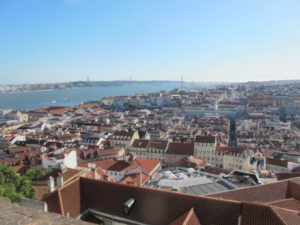
Today we left Seville and headed for Lisbon, Portugal.
Arriving in Lisbon, we went to look around the city. Mom and I headed for the Alfama district, a neighbourhood of narrow streets and cobbled roads. Of course, after we climbed much of the steep cobbled road we discovered near the top that there are also elevators.
We decided to go into St Jorge Castle http://castelodesaojorge.pt/en/plan-your-visit/, apparently a royal residence until the sixteenth century that is now an outdoor ruin. The views were spectacular from that height, and we took many photographs of the city with its white houses and roofs of orange clay tiles. The weather was quite windy and the cobbles were quite difficult to navigate.
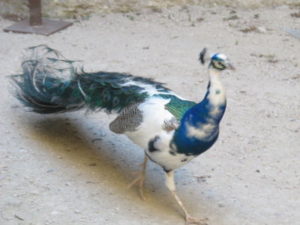
Mom was very excited to see how many peacocks also call this castle home and it was hard to pull her away from them even after dozens of photographs. I also took my share.
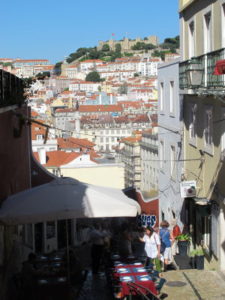
After we walked down the hill, again with difficulty because of the slippery cobbles, we found a covered market area with many little stalls in the Praca de Figueira and shared a ham-and-cheese sandwich. I tried a small sample of Portuguese port (apparently only fortified red wine from Portugal is allowed to be named port?) and also bought a whole delicious cup of olives for only one euro.
I love olives but also discovered there is possibly a limit to how many olives one should enjoy in a sitting as my lips swelled up a little probably from the salt.
Seville at 37 degrees Celsius
June 15, 2018
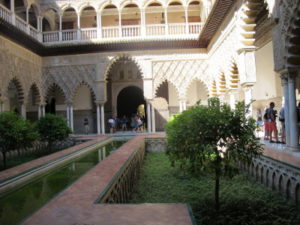
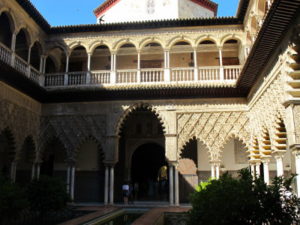
Today we started in Seville with a tour of the Moorish royal palace or Real Alcazar http://www.alcazarsevilla.org/english-version/. Built in 1364 within an existing palace, it is still the residence where the current monarchy stays in the city (had we come three days later it would have been closed for a royal visit).
We had a very good local guide here who not only explained what the rooms were for, but interesting tidbits like the fact that the lack of doors was to allow for good airflow (smart architects – Seville was our hottest stop so far). He showed us some of the elements within the Moorish carvings, like evergreens, shells and the different symbols from different religions like the five-pointed Jewish star, the six-pointed Islamic star and the three pointed star of Bethlehem. Lots of lovely tiles and ornate plasterwork here, and as you can see from the photos, arches and walkways. Lush gardens as well.
The Alcazar felt in some ways like and unlike the Alhambra in Granada, with the blend of Christian and Islamic decoration and the presence of many beautiful gardens being the biggest similarity. We are definitely seeing these in the right season, with flowers in full bloom including many rose gardens and lots of palms.
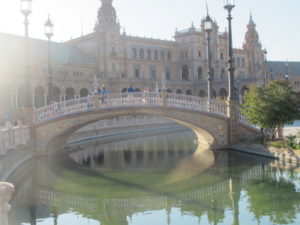
Before we got to the Alcazar we stopped at Maria Luisa Park and looked at the various pavilions built for the 1929 Ibero-American exhibition, now widely used for other purposes such as language schools and the university.
After the Alcazar, we went on a wander through the old town with its various plazas that were filled with horse-drawn carriages.
We broke from the group for lunch – Mom and I had sandwiches (more of that tasty serrano ham for me!) plus sangria. Then we went into the cathedral, which was an ideal destination because the high was 37 and felt it. I used to say my favourite temperature is in the thirties, but I have amended that lately to be to be closer to 30 than 40 degrees. Because over 35 Celius, you’re just melting.
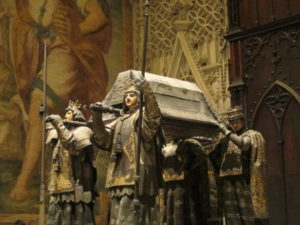
The cathedral, nice and cool, was built on the site of a mosque from the late 12th century, was completed in the 1500s and featured many chapels in the Gothic style. It is also famous for housing the tomb of Christopher Columbus, a legend our guide says was confirmed several years ago by DNA testing (lots of places try to claim Columbus – looking online I see the debate still rages and various tests are still ongoing, for example https://www.forbes.com/sites/kristinakillgrove/2018/01/19/dna-testing-of-skeleton-may-prove-christopher-columbus-was-really-portuguese/#59aeb1305c82).

After our cathedral visit it was so hot that Mom and I just went and sat at a café in the shade with glasses of sangria for a while. Then we went to the tourist office where we asked about places to check out some flamenco. I had done some research online the night before, but the tourist office also had a ready list of bars with free shows and performances charging admission.
We chose a show at the Spanish guitar museum https://www.flamencoensevilla.com/en/ nearby because the show was relatively early at 6:00 pm. More on flamenco in another post.
And now for a completely different country: Gibraltar
June 14, 2018
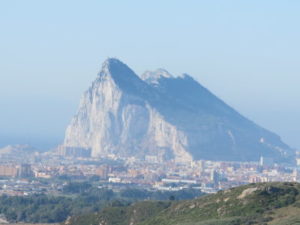
This morning we got an early start to Gibraltar, a British territory just across the border from Spain. Gibraltar or “Gib” as the locals sometimes call it, looks like a giant rock but in fact houses over 29,000 people with an economy currently booming with tourism and other industries. Fun fact that 85 percent of British betting is located there!
We took first photographs from a nice elevated point away from the city. It really does look like a giant rock sticking out of the landscape, from our angle a very tall peak. This is one place that I remember as a kid because Dad had a rock on his desk that he had picked up there as a souvenir and somehow I thought the rock was called Gibraltar, not realizing it was from a place (I told Mom this and she said she never realized this, was amused).
As we got closer, it was surprising to see a city emerge out of that far-away rock and realize a fully developed metropolis, with regular infrastructure like stores and apartment buildings.
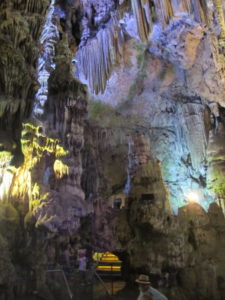
We walked across the border with our passports and then took a minibus tour of the rock where we learned some of its history. We drove up a very steep and windy road (again a time to say glad it’s not me driving) and arrived at St. Michael’s Cave, made of limestone.
This is the first cave I’ve ever been in (Mom corrects me to say that I was in a cave at age four, but I remind her that travel before age five doesn’t count as I do not remember a thing). The cave was spectacular and huge, quite well-lit with dramatic colours although I wonder if the pulsating musical background is taking it a bit too far.
The other attraction here is the Barbary Macaques, a population of apes without tails. They roam wild around the caves and are, of course, super-cute, although we’re warned they can bite if they feel threatened (how could you not with so many people snapping photos of you?). Our guide mentioned some are diabetic from being fed by tourists – there is a huge fine now for feeding them, and fortunately we didn’t witness any of that, although there were some people getting too close in their efforts to capture the perfect selfie. Sigh.
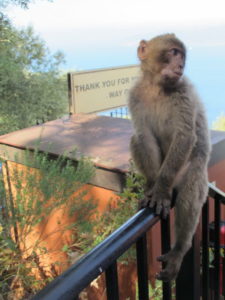
After our visit to the cave we returned down in our mini bus to the main square for lunch, where Mom and I had fish and chips. I also confirmed that YES THE CHOCOLATE THEY SELL HERE IS BRITISH (my favourite, sweeter and more buttery in flavour than North American) so acquired some to take home. Bonus!
After Gibraltar, we got back on the bus and made our way to Seville, our stop for the next two nights.
Alhambra then on to Malaga
June 13, 2018
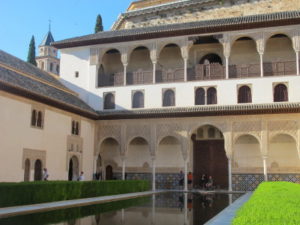
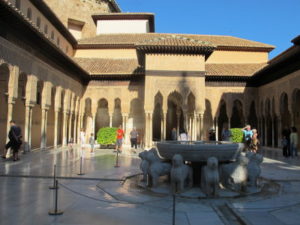
Today Mom and I visited the Moorish palace in Granada called the Alhambra https://tickets.alhambra-patronato.es/en/, built under Ismail I Yusuf I and Muhammad V, caliphs in the Nasrid dynasty. The complex is quite large with several buildings and gardens and walkways in between. Apparently, it has also been pillaged several times over the years, including an attempt by Napoleon’s troops to blow it up.
We had to catch a mini bus to get up the steep hill and narrow streets to the site, a real feat for the drivers. As soon as I saw the narrow, cobbled streets we had to travel, my question about why a mini bus rather than a regular bus was answered.
We arrived for a strict 9:00 am admission I had booked online (after the Sagrada Familia, I had started to check whether booking tickets online was required and here the website suggests booking a month in advance. Luckily, we got tickets with just 24 hours advance purchase. Also, we had to enter a lot of information including our passport numbers and ages).
With a limited time before our tour bus rolled away just before noon, we moved quickly to tour the buildings. The most impressive aspects are the walls and ceilings carved with Islamic patterns. Various rooms like the Salon des Embajadores (throne room), the Patio de Arrayanes with a reflecting pool and Patio de los Leones with a fountain resting on stone lions each have a different feel but also consistency in their plaster carvings and archways.
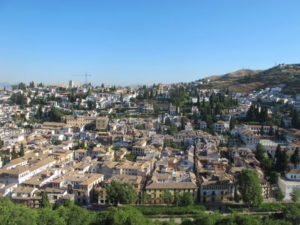
The Alhambra also had very impressive views of the city, especially the Albaicin quarter opposite, which we did not have much time for but started into on our way back from the Alhambra.
Granada was not on my radar as much as some of the other cities on our tour, but I thought it was probably the best example of the mixing of Christian and Moorish styles. I really liked it.
After leaving Granada, we drove to Malaga, a resort town along the coast known as a tourist hangout and for being the birthplace of Pablo Picasso.
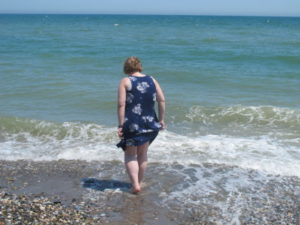
Our hotel here was the nicest one yet because it reminded me of a resort in the Caribbean. We had an ocean view with a balcony. Plus the hotel had a pool, fortunate because the ocean was unbelievably cold, like New England cold. So, we swam in the pool, which was not exactly hot but at least refreshing (there was also a heated indoor pool).
Later, Mom and I acquired some sangria from a corner store down the street. We sipped it out on our balcony while we watched the sun set and a surprising number of planes take off from Malaga airport (according to Google, it turns out to be the fourth busiest in Spain). On the fourth full day of the tour, the afternoon was a nice “vacation from our vacation”.
Long driving day with a reward of Granada
June 12, 2018
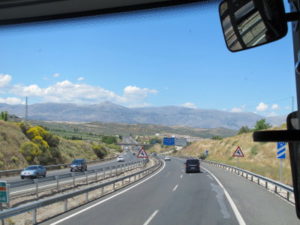
Today was the longest driving day of our tour thus far, broken by a couple of stops for lunch. We probably drove for around seven hours. Our tour guide Jorge has gotten in the habit of asking “Where would you like to go today?” to which the bus answers in unison with the city that is our destination. It’s a good rallying cry for driving.
He also starts by telling us a bit about the region and the cities, which I really appreciate. Today, he was telling us about the history of Spain and conflicts that have seen various regions be jointly or alternately controlled by Christian and Moorish influences.
To pass the time, he also showed the movie El Cid https://www.imdb.com/title/tt0054847/, a 1961 historical drama starring Charlton Heston and Sophia Loren about the Castilian knight Don Rodrigo Díaz de Vivar, or “El Cid,” who fought the North African Almoravides and helped the unification of Spain. The movie was partly filmed in Peniscola where we had stopped the other day.
The heaviest driving day seems like a good point to mention the varied landscape we have seen along the way. It variously features lots of mountains, scrubby landscape in the hotter areas, and lots of olive and almond trees. Driving along the coasts, Costa de Blanca along the west and Costa del Sol along the south, there have also been many panoramas overlooking water. A common site in the cities is the number of clay roofs and houses whitewashed to deflect the sun. There are lots of tourist towns along this coast, like the city of Benidorm apparently known for its resorts.
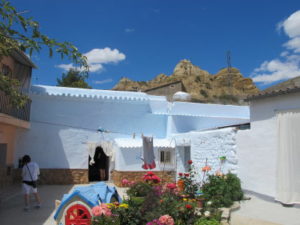
One of today’s stops was in a town called Guadix, about 50 km from our destination of Granada, to see cave houses, exactly what it sounds like that part of a person’s house is in a cave (guidebook says there are over 2,000 of them here!).
Our tour guide took us into one cave house and the whitewashed walls were three or four feet thick and surprisingly cool inside considering the weather outside was nearing 30 degrees Celsius. Apparently the temperature inside is consistently around 20 Celsius all year.
A couple of hours later, we landed in our hotel in downtown Granada. We went to look around at the cathedral and narrow cobbled market streets, where little shops were selling silk scarves and other souvenirs. I really liked the blending of different styles in Granada, representing the Christian and the Moorish which have variously occupied the area since the eighth century.
Tonight, we had dinner with our tour group in our hotel and we were serenaded by some Spanish guitar singers who were also science students at the local university.
Barcelona to Valencia
June 11, 2018
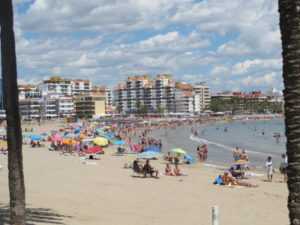
Today we left Barcelona with the tour for our next stop in Valencia where we would spend the night. We made a stop for lunch in Peniscola (pronounced penish-cola) and walked around the fortified old town built around of the base of a castle, Castell del Papa Luna.
This was a nice example of a smaller centre with lots of tapas restaurants and a nice beach where I took off my sandals to walk in the surf.
We had a nice tapas lunch of Spanish omelette and the best vermouth I’ve tasted.
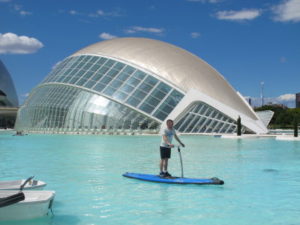
Later on in the afternoon, our tour bus arrived in Valencia, Spain’s third largest city after Barcelona and Madrid, and looked around various areas.
First, we went to see the Ciutat de les Arts I de les Ciencies, or City of Arts and Sciences, a very impressive set of modern buildings that houses a science museum and performance centre and planetarium. Created by architect Santiago Calatrava (and still under construction as of the printing of my 2004 guidebook, ha), the buildings look really futuristic with glass and concrete set around a large lake.
In the midst of seeing so many old squares in Europe, a visitor sometimes wonders what new wonders have been created since the days when cobblestones were the height of fashion, so this was a great example of a very contemporary development. Definitely not there at the time of Mom’s visit.
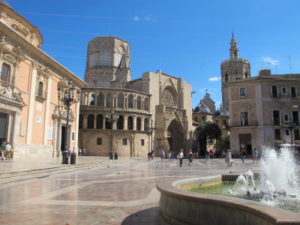
Afterwards we returned to earlier centuries in the old town, apparently founded by the Romans in 138 BC, conquered by the Moors and later captured by El Cid in 1096 and again by Jaime 1 the Conqueror in 1236.
We walked around the main square Plaza de la Reina and the Palau de la Generaliat, a former palace now used by the regional government and built in the Gothic style.
We took an audio guided tour of the Cathedral. It was built in 1262 and contains a cup claimed to be the Holy Grail. Later we returned to our hotel and had dinner there with the group, a giant chicken paella (traditional Spanish rice dish) which was brought out by the kitchen staff for viewing and photographs before being devoured by the hungry travellers.
From mystical Montserrat to a dip in the pool
June 10, 2018
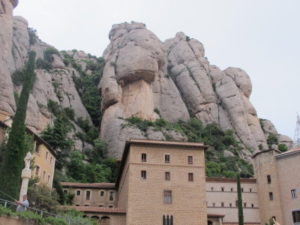
Today our official tour (Cost Saver 13-day Iberian Explorer with Trafalgar https://www.costsavertour.com/en-ca) began in earnest. First, we went to Montserrat, a monastery just outside Barcelona. It is set in the “serrated mountains” (=mont serrat) where the highest peak is just over 4,000 feet.
The Montserrat tour was one of several optional excursions offered by our tour, of which Mom and I chose mostly the historical tours (special dinners were also on offer but we mostly did our own thing for meals).
According to my guidebook, the Montserrat monastery was started in the ninth century enlarged in the eleventh century and destroyed in the Catalonian war of independence in 1811 but rebuilt in 1844. Today, Benedictine monks live in the monastery, which is accessible by train as well and houses funiculars (we would call cable cars in north America) to transport visitors above to more hills for walking. Apparently, the monastery is a two-hour climb on foot. There were lots of climbers on site. Here’s a nice virtual tour I found online http://venuetour.net/projects/montserrat/?initialScene=scene_1_basilica&qlang=en (a bit slow depending on your internet connection).
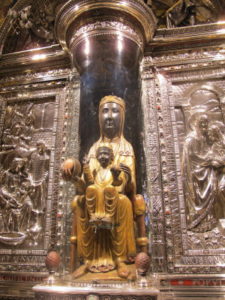
Inside, the famous Virgin of Montserrat or “black Madonna” is the statue that many tourists come to see. She’s believed to have been made by St. Luke and brought there by St. Peter in 50 AD according to my guidebook. Our tour guide says that people pray to her for all sorts, including fertility and general good fortune.
We lit a candle for my Dad (my parents had previously visited the monastery) and took lots of pictures of the exterior that stands against the mountains, as well as the cable cars and vistas you can see from the top. Outside there were several vendors selling fresh cheeses and handing out samples! Tasty.
After returning from Montserrat, we went downtown for a guided tour of Barcelona. We drove by the Eixample and Montjuic neighbourhoods, where we saw areas like the Place d’Espanya with the Palau National and a “dancing fountain” that is lit at night with different colours and set to music. We went to the Olympic park and saw the buildings built for the 1992 Olympics.
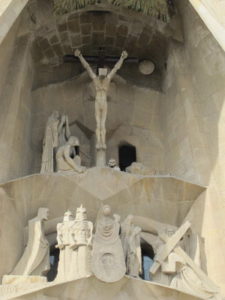
Our tour ended with a stop at the Sagrada Familia and our tour guide clarified that much of the art outside that I had been thinking of as Gaudi’s were by another artist, Josep Maria Subirachs. Apparently the plans for the church were made by Gaudi but it was also decided that others could put their own style on the areas they completed (seems fair).
After the tour, we were dropped off in Las Ramblas where we went again for a bit of tapas (I could get used to this lifestyle…) before returning to our hotel to test out the pool (25 Celsius, water still cold but refreshing) and have some sangria and pizza. Vacation!
Visiting Gaudi and joining the tour
June 9, 2018
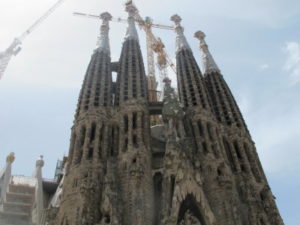
First thing in the morning, as planned, we visited the Sagrada Familia and it turns out tickets sell out early! We arrived around 10:30 after an hour on the metro, and the only tickets left were for 7:00 pm. And it took an hour waiting in line to get them.
We also learned online ticket sales are a safer bet now, a lesson reinforced at the next attraction we tried to visit, the Casa Batllo, a house commission completed by Gaudi, where the prices were lower for online tickets than they are if you buy them in person.
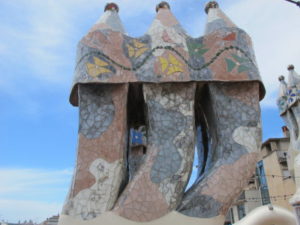
Barcelona is full of Gaudi architecture including Casa Mila (La Pedrera), an apartment building with a front that looks like waves, and a park north of the city called Guell that we didn’t end up being able to see. Casa Batllo is apparently known locally as the “house of bones” because the front has a skeletal appearance especially around the windows.
Inside, the house is empty, but the tour used some augmented reality technology where you held the iPhone guide they provide in front of you and it superimposes furniture from the original house on the rooms. It also superimposes fantastical elements like fish swimming by in the inner courtyard (designed by Gaudi to look watery, we learned). The house gave a decent sense of the Gaudi style, with its constistently curving lines and whimsical chimneys and tiles on the roof and courtyard.
After the Gaudi house, we went for some lunch at a huge food market just off Las Ramblas where I had a cone of meat which was exactly what it sounds like (I’m really liking this Serrano ham!). Then we went down to see the Barcelona cathedral, a lovely old Gothic building with a Romanesque chapel. According to my guidebook, it was built in 1298 and finished in the late nineteenth century. The square in front was also quite lively with actors posing as historical figures for tourists to take their picture (there was quite a convincing statue with a telescope – Galileo?) and tourists milling around in the heat.
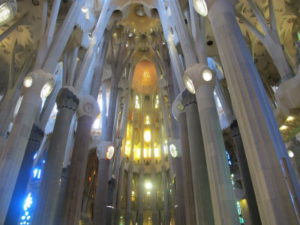
Later in the afternoon we went back to our hotel and met with our tour group and guide Jorge, but then had to rush away to make use of our late tickets to the Sagrada Familia (which I only later learned means “holy family”). The trip was worth the effort as the inside is just as fantastic as the outside. Perhaps even more so with its very high ceilings and interesting buttresses curving upwards.
The modernist stained-glass windows with many colours were also gorgeous, and the church managed to maintain a serenity and sacredness despite the tourists milling about. A very modern crucifix hanging above the altar and a door made of words were other interesting aspects of the interior.
We also visited a museum inside the Sagrada with details of the making of the cathedral. We learned that it now has an estimated completion date of 2026. Outside, we took some evening pictures as well, although even near 9:30 it was still not nearly dark enough to turn on the lights that illuminate the building at night.
Welcome to Barcelona
June 8, 2018
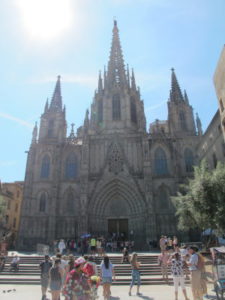
After a breakfast of delicious chocolate croissants acquired from the grocery store, we set out for our first full day in Barcelona. We headed for the Gothic Quarter (Barri Gotic), the oldest part of the city. We tried to find the various landmarks from the guidebook, including the cathedral, the Palau de la Generaliat, the Palau Reial and the Museu d’Historia de la Ciutat. We also went down into the Parc de la Ciutadella where we saw the Arc del Triomf that was the main gateway to the 1888 Universal Exhibition in the park.
Next, we went to visit Barcelona’s Museu d’Historia de la Cuitat https://www.barcelona.de/en/barcelona-museum-city-history.html which my guidebook says contains the “most extensive and complete subterranean Roman ruins in the world.” The ruins feature streets and squares from the old “Bacino” (former name for Barcelona) and were discovered in 1931. From the walkway above the ruins you can see baths, homes with mosaic floors and laundries. It’s neat to think not only that this was buried underground, but that the tourists walking above wouldn’t even know about this extensive ruin unless they visited. The museum also included an interesting short film showing the way that Barcelona had grown in terms of population and shrunk in terms of shoreline recession since ancient times.
After the museum, we came out to the courtyard and had a glass of wine in the cobbled square. Refreshing!
At the Sagrada Familia http://www.sagradafamilia.org/en/ is where my mother’s past visit to Spain becomes most relevant because she really fell in love with modernist architect Antoni Guadi’s architecture. But she recalls it under construction. Surely it would be finished by the time she returned? Not so. Cranes are one of the first things you notice about the site, of course alongside the fantastic architectural style with unusual curves and signature turrets and use of mosaic. According to my guidebook, construction was started on the Roman Catholic cathedral in 1882.
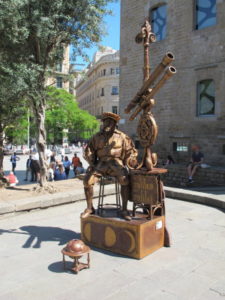
To explain a bit more about my mother’s history in Spain: when they were in their mid-20s, my parents went touring around Europe for 14 months. They bought a trailer and a Volkswagen to pull it and went from campsite to campsite seeing all the major sights. They wintered in Spain, which sounds decadent, and in practical terms the warmest place to go in the winter. So, they spent almost three months here!
This is the 50th anniversary of their visit so it’s understandable that it’s hard to recall exact details. Although Mom does marvel at the crowds. I guess mass tourism was just beginning when she was here (the first guidebooks were being published). Today the results of 50 years of people awakening to travel have materialized in long lineups at some attractions.
Which brings us back to the Sagrada Familia where tickets were sold out for the day. So we went for tapas instead, and then home with a plan to return first thing in the morning.
Montreal to Barcelona June 7-22
June 7, 2018
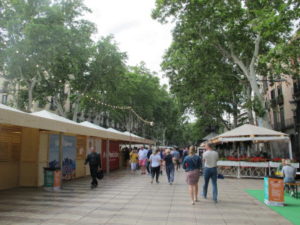
The first day of our trip, June 7, was one big 30+ hour day. While I live in Toronto, we decided to fly out of Montreal because it’s closer to my mother and we got a decent flight deal. We took the red eye so the main hardship to start was the jet lag.
I am of the school that you should stay up to acclimatize to the new time zone. So even though it was 5:00 am our time when we arrived at noon in Barcelona, we tried to stay awake.
First task was to make our way from the airport to the hotel, which turned out to be easiest by city bus, fortunate at only 2.20 euro each for the trip.
Landing at our hotel and realizing it was somewhat far from downtown, we quickly got back on transit. We made our way by tram and then metro to La Rambla (sometimes pluralized to Las Ramblas?), the famed shopping street in Barcelona that starts at the city’s waterfront.
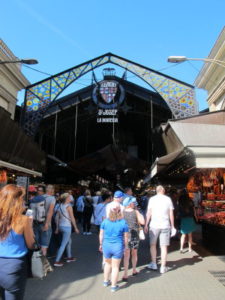
We stopped first at the Christopher Columbus monument near the port. The monument is a 60-metre column designed for the 1888 Universal Exhibition and marks the spot where Columbus stepped ashore after returning from America in 1493.
We began walking up La Rambla where there are lots of souvenir and food stalls and flower shops as well as outdoor patios, our first glimpse of the Spanish lifestyle of socializing over small appetizers or tapas.
We had a good lunch (what do you call the first meal off the plane when you haven’t slept for 30 hours?) at an all-you-can-eat tapas restaurant which was helpful for sampling popular tapas and foods: olives, seafood paella, chorizo sausage, mussels, tostas and others. We also sampled the inexpensive drinks at 2.65 euro for a glass of wine.
After our ramble up the Ramblas and back down to the boardwalk area by the port, we finally went home and got to bed early.
Deciding on Spain
June 6, 2018
After lots of planning and preparation for travel to my next bucket list destination of Spain…no, scratch that, because the truth is that I decided, for the first time since I was 22, to sign up for a tour rather than plan and book the trip myself. I also signed up my mother, Sandra, who is an even more experienced traveler than I am (more on that later) and game to try a thirteen-day tour starting in Barcelona and ending in Madrid, with Lisbon, Portugal, included as well.
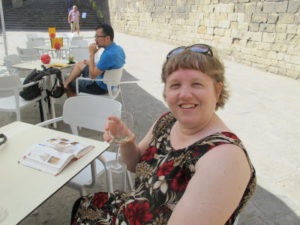
So, less planning than usual in that I didn’t book my hotels or plan the route: my only initial input was some careful study of various travel brochures and timelines and price points.
With the major planning off my plate, I managed to push learning about the cities we would see until the Sunday before leaving, when I spent a whole afternoon closely reading the 2004 DK Spain guidebook that my Dad had loaned me when I first mentioned an interest in Spain. I also tried to review my nonexistent Spanish, a language that I’ve been idly trying to learn over the past few years through audio lessons. A little too idly as it turns out, since I didn’t have that many words. Hola.
In all, a few things would be the same as usual for this trip and a few things different.
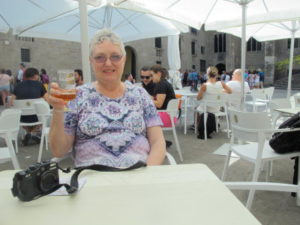
Same in that I travelled with my mother as I have in the past. We travel well together (and have done so a few times since my Dad passed away four years ago) as we generally like the same things: great landscapes and the occasional museum and other cultural aspects and a glass of wine at the end of the day and sometimes in the middle of the day. We are decently easy going and my Mom often lets me take charge of some planning without much complaint even when I sometimes get it wrong with my questionable sense of direction.
Same in that I had tried out the guided tour format in the past, but 20 years ago when I was 22. At that time, I was very green as a traveler. As in, never got on a plane green. As in, never travelled without Mom and Dad green. But I went with my friend Tara and taking a tour (Contiki) was a good way to get oriented both to Europe and to overseas travel. Yes, the trip was quick (10 countries, 16 days, with a couple extra in our starting point of London, England) but it did give me the confidence to start planning my own trips, booking hostels and Eurrail passes.
This trip is different in that I’ve never been to Spain–it’s been on my travel bucket list for a while.
Different in that I have never flown into one airport (Barcelona) and out of another (Madrid). That feels very efficient.
But first back to the familiar, as in the familiarity of a cramped airline seat and a little TV dinner meal, and shared screens in the middle of the aisle for almost seven hours on a bus in the sky. But uneventful, relatively low turbulence—it’s hard to ask for more than that from a flight. Here we go.
